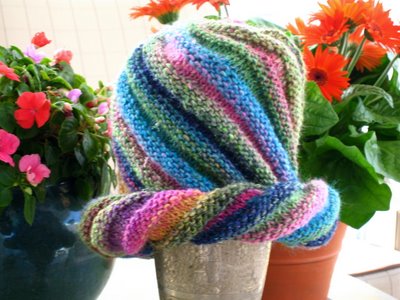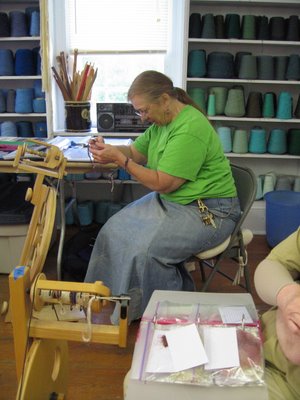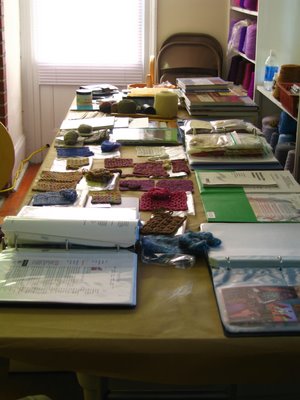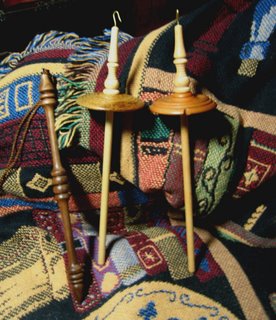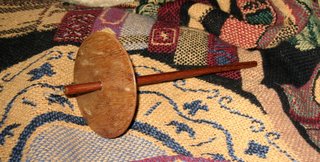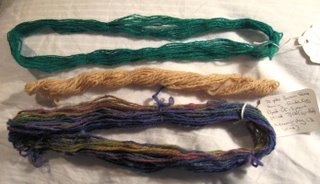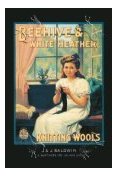
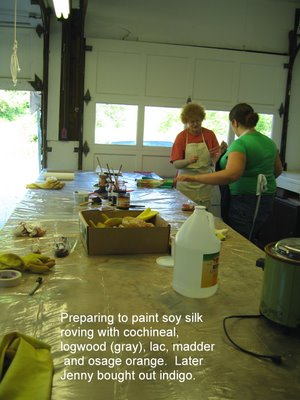
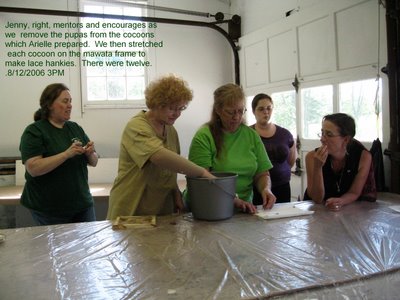 What I Did On My Summer Vacation, Or, What I Learned From Jenny Bakriges.
What I Did On My Summer Vacation, Or, What I Learned From Jenny Bakriges. It's hard not to rave about Jenny. I found her to be a wonderful teacher. Her patience, good humor, frankness and clarity made this among the most successful learning experiences I've ever had. She advocates certain quite defined spinning practices but never strays into orthodoxy, as some teachers do. Throughout the workshop she stressed that these were her methods, perfected for herself and used to obtain excellent results. However, Jenny said we'd find many other approaches and encouraged us to find our own methods.
Jenny teaches by explaining, showing, demonstrating and sharing so much material that one has weeks, even months of 'homework', if so desired. Every time I take a spinning class I'm overwhelmed by the teachers' generosity and enthusiasm. They all give so much of themselves and eagerly share their expertise. They also understand that the students are making what is for many a huge investment of time and money. A classmate told me that she and her friend had agreed that they'd gotten their money's worth by the end of the first day. Those signed up for her SOAR class are in for a big treat.
I'm a plodding sort of learner who likes to explore something quite thoroughly before going on. Luckily the class wasn't structured to go according to my rhythms or else we wouldn't have gotten much past Friday! Because Jenny explained everything so thoroughly, I quietly put my fiber samples in little plastic bags with relevant notes and know I can practice on my own.
The Techniques Jenny Stresses* Always make a ply sample when beginning a new yarn spinning project. Keep it as yarn stored even a day on the cop or bobbin will relax too much to give a true ply-back.
* Card carefully and pay attention because it's important to do it well. Remember, fiber prep is the key to good spinning.
* Plying takes concentration. Give yourself the time needed and avoid distraction. Jenny showed us how to count as you pull the plies toward you and then let then in (3 or 4 up to your body, 3 or 4 into orifice). The hand separating plies oughtn't to be forward.
* Always, always pull out fibers from the end of a roving, sliver, etc. to check fiber length before carding
and spinning.
* Fudging joins (of which I am guilty) while spinning silk results in wrinkled, fibrulated yarn, especially in silk
*The 'yarn package' is very important to plying. I'm not so clear about this but it somehow involves the additional step of taking the yarn off the cop of the spindle or the bobbin before plying. That I learned makes a big difference.
What The Workshop Covered (Order Is Subject To Quirky Memory Kinks)Friday MorningFirst of all, we walked into a room revealing hours of preparation Jenny had put in. She'd even hung up a poster about making silk she'd especially ordered from England. Two long tables were set up with with samples of her beautiful work we've all drooled over in SpinOff, many labeled swatches, books, looseleaf binders. I confess I didn't spend enough time looking these over.
MorningFibers handed out:
(I dyed all three of these on Sunday with indigo. The little skeins are all sitting in my kitchen, "curing", awaiting their rinse tomorrow evening.
*80% merino/ 20% silk. I spun this very loose and soft; it should have been more tightly spun.
*silk and cotton -- I made a fine, little skinny thread.
*tussah -- I just love the feel of this and the ease of spinning
*Bombyx mori -- lovely
*silk/angora/merino (haven't done it..)
While we were spinning away, Jenny read and spoke about forms of silk and its properties. Meanwhile Arielle, under Jenny's guidance, was "cooking up" the cocoons we were to use that afternoon.
Jenny put out 4 oz. bags of silk roving in various colorways and let us each choose a number from a (of course felted) hat. I was lucky to pick #1 so I got to select first and won a beautiful deep fuschia and blue combination. Jenny had dyed all these when she was co-owner of Copper Moth. She gave the class a challenge. We are to spin the silk, make a scarf and share the results sometime in the future. My idea of homework heaven.
Friday Afternoon* Sari silk -- I spun it into a tight, cord-like little skein
*We each received one of the cocoons Ariel had prepared. Our task was to remove the pupa and pull the silk into a usable form. Some people spun theirs but Jenny suggested that I try to knit it up unspun. I pulled out the silk, wound it on a little wooden distaff and took it home to knit that evening.did and sill post about it later.gave us one processed cocoon. I pulled out the silk into a continious strand but didn't spin it. Instead, I wound it on a distaff and knitted it up that evening. I'll post a photo eventually.
* We pulled apart a dyed hankie into its layers and spun it. (I have one layer left)
* Jenny took out a large package of lace hankies and gave us each a few. (I haven't spun it yet)
* Jenny had us take apart a silk cap, too. - yet to be spun.
* Using the rest of the cocoons prepared that morning, we removed the pupas and other detritus and stretched the silk out on mawata frames to dry. There were about 12 layers. (See the third photo.)
Saturday MorningFibers distributed:
*Camel & silk -- I have three skeins as Jenny suggested I try it at varying thicknesses.
* cotton and cut silk -- not yet spun
We worked on carding and I almost learned it. I love Jenny's method but as I got tired I reverted to the one I'd learned last year in Andrea Mielke's class at MAFA. I think hers is based on Mabel Ross?? I wanted more practice but there wasn't enough time. When I'd gotten the materials list I bought, on Jenny's recommendation, the large Louet cotton cards. They are really wonderful and easy to use.
We made rolags, cigars and some have have made batts. Among the fibers we carded were:
*50%silk/50% cotton cochineal dyed by Jenny and made by the class into punis on the stick she gave us.
*Romney and Tussah, I only made one nest; the rest is waiting.
The fibers available to combine with our cards:
These are the ones I haven't gotten to and can't wait until I do: Medium (gray) coopworth; more Tussah; Yak -- will card with either tussah or bombyx mori; Alpaca - will card with camel/silk blend; "Multicolor silk blend" by Treenway, floor sweepings from silk mill which I'll Combine with some grey fibers; Hemp, very sturdy; Mohair
(Plan: combine mohair, medium coopworth and multicolor silk blend?); Tussah noil; more Bombyx mori; more 80%merino/20%silk
Blended but not spun:
*I carded fuschia corriedale with bombyx and made it into nests from the cigars - not yet spun.
*I carded a lovely 85%merino/15% silk by Gaywool in "Camellia" carded with "Sparkle. White", a glittery polyester. Nests in bag waiting to be spun.
While we drooled over the array of choices and tried to choose among them to spin, Jenny demonstrated and talked about plying. I'm trying to take in all the information as this is definitely an area where I do need to work. Jenny showed us the "Magic water test", used to find the plyback of "dead yarns". We learned that silk will sometimes not ply back properly when too relaxed.
Below: Classmate B. with her wild moth silk stretched on the mawata frames. This is very special, rare expertise so we were all thrilled.
 Sunday
Sunday After initial chatting and information exchanges, the class watched a video made in England about the silk industry. Short and informative. Then we traipsed back down to our "wet lab" to space dye lengths of soy silk roving with cochineal, logwood (grey), lac, osage orange. Indigo was brought out at the end. I divided mine into 6 strands and tried for a greenish shade on one by combining osage orange (?) and logwood gray. Since I had gloves on and no notebook at hand, I haven't a clue. Eventually I'll post a photo of the soy silk rovingettes.
Sunday's topic was artifically produced silken fibers. First I spun space-dyed 'Kareoke' in "Rainbow" by Southwest Trading, a soy silk and wool. Jenny gave us little felt balls to wind the yarn on to be steamed and relaxed. I do see the advantage to relaxed yarn because it was much easier to Navajo ply later. Unfortunately, because my loops were quite long, the colors barber-poled and became muddier than they'd been on the ball. I haven't yet tried the "Magic Water" trick to wake up the twist and balance the yarn.
FIBERS DISTRIBUTED
A. Not used yet
Soy silk; Uncarded nylon "fake cashmere" by Louet; "Eco Pet", uncarded polyester from recycled bottles; "Optim" -- super processed wool; Bamboo; Silk latte; purple inego roving -- all the class but M. despised it. I didn't try it; 50%superwash/50%tencel in "Truffle"; Littlefarm's open uncarded Tencel; degummed "throwster' silk waste.

